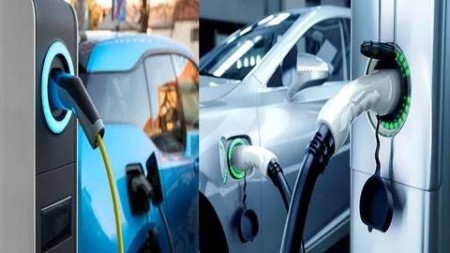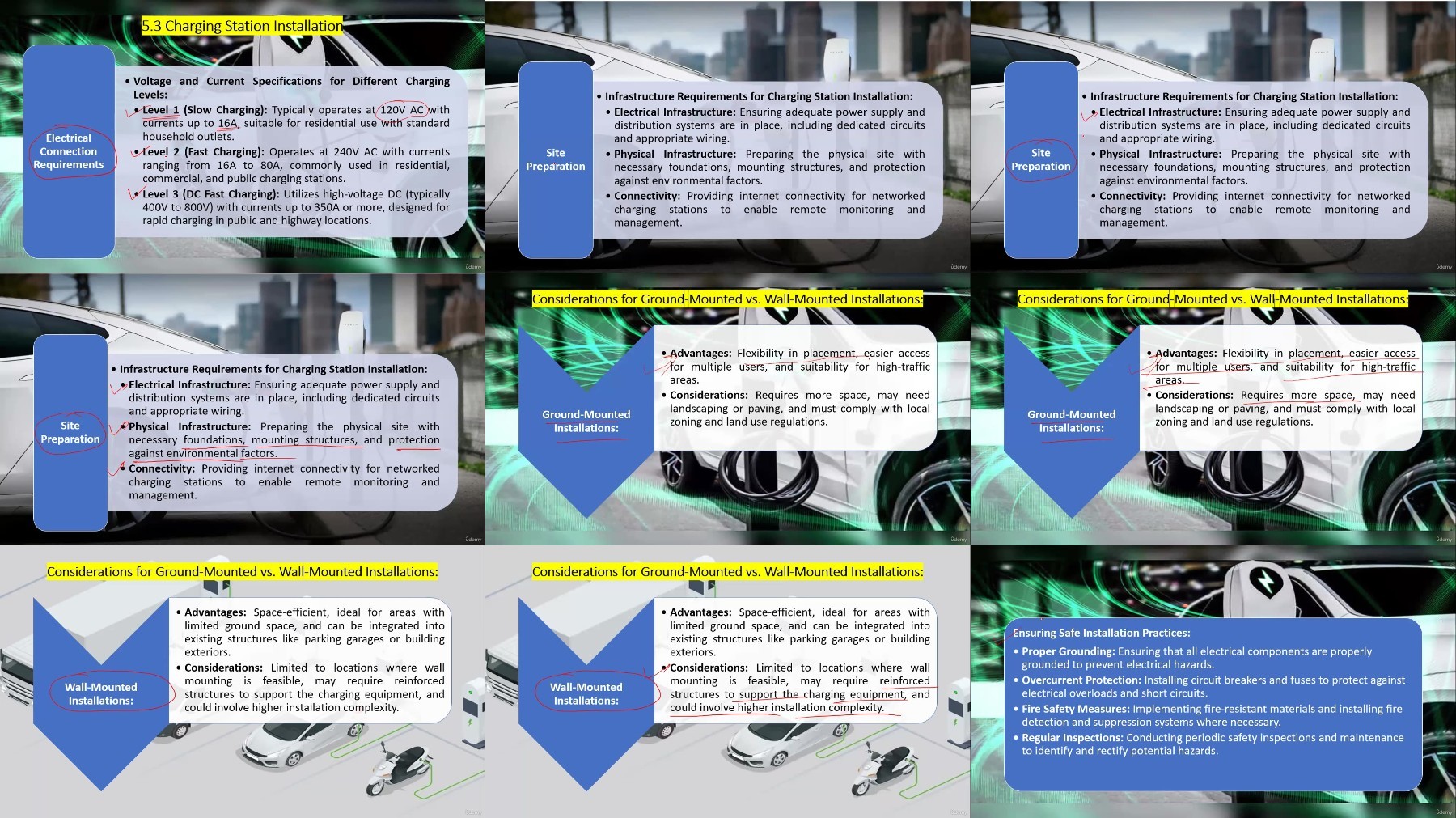Most Commented
Electric Vehicle (Ev) Charging Infrastructure Planning




Description material

Electric Vehicle (Ev) Charging Infrastructure Planning
Published 10/2024
MP4 | Video: h264, 1920x1080 | Audio: AAC, 44.1 KHz
Language: English | Size: 2.60 GB | Duration: 3h 30m
Guide for your Sustainable Learnings
What you'll learn
Introduction to Electric Vehicles and Charging Infrastructure
Introduction to Electric Vehicles (EVs)
Types of Electric Vehicles
Advantages of Electric Vehicles
Evolution of the Electric Vehicle Market
Importance of Charging Infrastructure for EV Adoption
Challenges and Opportunities
Regulatory Landscape
Role of Stakeholders in EV Adoption
International Perspectives
Types of Electric Vehicle Charging
Overview of Charging Technologies
Slow vs. Fast Charging
Charging Standards and Connectors
Charging Infrastructure Deployment Strategies
Role of Smart Charging in Infrastructure Development
Site Selection for Charging Stations
Business Models for Charging Infrastructure
Economic Considerations
Regulatory and Policy Considerations
Grid Capacity and Integration Issues
Future Trends in Charging Infrastructure
Successful Charging Infrastructure Deployments
Site Selection and Planning
Factors Influencing Site Selection
Regulatory Considerations
Infrastructure Requirements and Constraints
Integration with Existing Infrastructure
User Experience and Convenience
Future-Proofing and Scalability
Cost-Benefit Analysis
Public Outreach and Community Engagement
Security and Safety Measures
Analysis of Successful Site Selection and Planning
Grid Integration and Power Management
Understanding the Electrical Grid
Grid Impact Assessment
Power Management Strategies
Energy Storage Integration
Vehicle-to-Grid (V2G) Technology
Grid Interoperability
Grid Resilience and Reliability
Overcoming Grid Constraints
Data Management and Analytics
Grid Integration Challenges and Solutions
Technology and Equipment
Overview of Charging Station Components
Charging Station Architectures
Charging Station Installation
EV Charging Connectors and Cables
Communication Protocols
Smart Charging Technologies
Advanced Charging Technologies
Battery Technologies
Thermal Management Systems
User Interface and Experience
Maintenance and Monitoring Systems
Business Models and Funding
Business Models for EV Charging Infrastructure
Revenue Generation Strategies
Funding Sources for EV Charging Infrastructure
Financial Planning for Charging Infrastructure
Funding Allocation and Budgeting
Business Strategies and Market Positioning
Risk Management Strategies
Case Studies and Best Practices
Importance of Case Studies in EV Charging Infrastructure
Case Studies on Successful Charging Infrastructure Deployments
Lessons Learned from Past Charging Infrastructure Projects
Best Practices in Planning and Design
Operational Excellence and Maintenance
Financial Sustainability and Funding Strategies
Inclusivity and Social Impact
Environmental Sustainability
Technological Innovation and Integration
Requirements
No prior experience is needed. You will learn everything about Electric Vehicle (EV) Charging Infrastructure Planning of Solar Power Plant in this course
Description
In this course you will learn following points in detail:Introduction to Electric Vehicles and Charging InfrastructureIntroduction to Electric Vehicles (EVs)Types of Electric VehiclesAdvantages of Electric VehiclesEvolution of the Electric Vehicle MarketImportance of Charging Infrastructure for EV AdoptionChallenges and OpportunitiesRegulatory LandscapeRole of Stakeholders in EV AdoptionInternational PerspectivesTypes of Electric Vehicle ChargingOverview of Charging TechnologiesSlow vs. Fast ChargingCharging Standards and ConnectorsCharging Infrastructure Deployment StrategiesRole of Smart Charging in Infrastructure DevelopmentSite Selection for Charging StationsBusiness Models for Charging InfrastructureEconomic ConsiderationsRegulatory and Policy ConsiderationsGrid Capacity and Integration IssuesFuture Trends in Charging InfrastructureSuccessful Charging Infrastructure DeploymentsSite Selection and PlanningFactors Influencing Site SelectionRegulatory ConsiderationsInfrastructure Requirements and ConstraintsIntegration with Existing InfrastructureUser Experience and ConvenienceFuture-Proofing and ScalabilityCost-Benefit AnalysisPublic Outreach and Community EngagementSecurity and Safety MeasuresAnalysis of Successful Site Selection and PlanningGrid Integration and Power ManagementUnderstanding the Electrical GridGrid Impact AssessmentPower Management StrategiesEnergy Storage IntegrationVehicle-to-Grid (V2G) TechnologyGrid InteroperabilityGrid Resilience and ReliabilityOvercoming Grid ConstraintsData Management and AnalyticsGrid Integration Challenges and SolutionsTechnology and EquipmentOverview of Charging Station ComponentsCharging Station ArchitecturesCharging Station InstallationEV Charging Connectors and CablesCommunication ProtocolsSmart Charging TechnologiesAdvanced Charging TechnologiesBattery TechnologiesThermal Management SystemsUser Interface and ExperienceMaintenance and Monitoring SystemsBusiness Models and FundingBusiness Models for EV Charging InfrastructureRevenue Generation StrategiesFunding Sources for EV Charging InfrastructureFinancial Planning for Charging InfrastructureFunding Allocation and BudgetingBusiness Strategies and Market PositioningRisk Management StrategiesCase Studies and Best PracticesImportance of Case Studies in EV Charging InfrastructureCase Studies on Successful Charging Infrastructure DeploymentsLessons Learned from Past Charging Infrastructure ProjectsBest Practices in Planning and DesignOperational Excellence and MaintenanceFinancial Sustainability and Funding StrategiesInclusivity and Social ImpactEnvironmental SustainabilityTechnological Innovation and Integration
Overview
Section 1: Introduction to Electric Vehicles and Charging Infrastructure
Lecture 1 Introduction to Electric Vehicles (EVs)
Lecture 2 Types of Electric Vehicles
Lecture 3 Advantages of Electric Vehicles
Lecture 4 Evolution of the Electric Vehicle Market
Lecture 5 Importance of Charging Infrastructure for EV Adoption
Lecture 6 Challenges and Opportunities
Lecture 7 Regulatory Landscape
Lecture 8 Role of Stakeholders in EV Adoption
Lecture 9 International Perspectives
Section 2: Types of Electric Vehicle Charging
Lecture 10 Overview of Charging Technologies
Lecture 11 Slow vs. Fast Charging
Lecture 12 Charging Standards and Connectors
Lecture 13 Charging Infrastructure Deployment Strategies
Lecture 14 Role of Smart Charging in Infrastructure Development
Lecture 15 Site Selection for Charging Stations
Lecture 16 Business Models for Charging Infrastructure
Lecture 17 Economic Considerations
Lecture 18 Regulatory and Policy Considerations
Lecture 19 Grid Capacity and Integration Issues
Lecture 20 Future Trends in Charging Infrastructure
Lecture 21 Successful Charging Infrastructure Deployments
Section 3: Site Selection and Planning
Lecture 22 Factors Influencing Site Selection
Lecture 23 Regulatory Considerations
Lecture 24 Infrastructure Requirements and Constraints
Lecture 25 Integration with Existing Infrastructure
Lecture 26 User Experience and Convenience
Lecture 27 Future-Proofing and Scalability
Lecture 28 Cost-Benefit Analysis
Lecture 29 Public Outreach and Community Engagement
Lecture 30 Security and Safety Measures
Lecture 31 Analysis of Successful Site Selection and Planning
Section 4: Grid Integration and Power Management
Lecture 32 Understanding the Electrical Grid
Lecture 33 Grid Impact Assessment
Lecture 34 Power Management Strategies
Lecture 35 Energy Storage Integration
Lecture 36 Vehicle-to-Grid (V2G) Technology
Lecture 37 Grid Interoperability
Lecture 38 Grid Resilience and Reliability
Lecture 39 Overcoming Grid Constraints
Lecture 40 Data Management and Analytics
Lecture 41 Grid Integration Challenges and Solutions
Section 5: Technology and Equipment
Lecture 42 Overview of Charging Station Components
Lecture 43 Charging Station Architectures
Lecture 44 Charging Station Installation
Lecture 45 EV Charging Connectors and Cables
Lecture 46 Communication Protocols
Lecture 47 Smart Charging Technologies
Lecture 48 Advanced Charging Technologies
Lecture 49 Battery Technologies
Lecture 50 Thermal Management Systems
Lecture 51 User Interface and Experience
Lecture 52 Maintenance and Monitoring Systems
Section 6: Business Models and Funding
Lecture 53 Business Models for EV Charging Infrastructure
Lecture 54 Revenue Generation Strategies
Lecture 55 Funding Sources for EV Charging Infrastructure
Lecture 56 Financial Planning for Charging Infrastructure
Lecture 57 Funding Allocation and Budgeting
Lecture 58 Business Strategies and Market Positioning
Lecture 59 Risk Management Strategies
Section 7: Case Studies and Best Practices
Lecture 60 Importance of Case Studies in EV Charging Infrastructure
Lecture 61 Case Studies on Successful Charging Infrastructure Deployments
Lecture 62 Lessons Learned from Past Charging Infrastructure Projects
Lecture 63 Best Practices in Planning and Design
Lecture 64 Operational Excellence and Maintenance
Lecture 65 Financial Sustainability and Funding Strategies
Lecture 66 Inclusivity and Social Impact
Lecture 67 Environmental Sustainability
Lecture 68 Technological Innovation and Integration
Lecture 69 Future Trends and Innovations
Electric Vehicle Manufacturers,Engineering Students,Electric Vehicle Investor,Electric Vehicle Developer,Electric Vehicle Engineers

FileAxa
Warning! You are not allowed to view this text.
RapidGator
Warning! You are not allowed to view this text.
FileStore
TurboBit
Warning! You are not allowed to view this text.
Join to our telegram Group
Information
Users of Guests are not allowed to comment this publication.
Users of Guests are not allowed to comment this publication.
Choose Site Language
Recommended news
Commented



![eM Client Pro 9.2.1735 Multilingual [Updated]](https://pikky.net/medium/wXgc.png)






![Movavi Video Editor 24.0.2.0 Multilingual [ Updated]](https://pikky.net/medium/qhrc.png)

